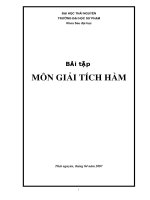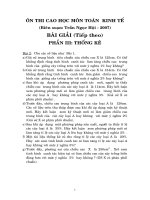On thi cao hoc DHQG ha noi
Bạn đang xem bản rút gọn của tài liệu. Xem và tải ngay bản đầy đủ của tài liệu tại đây (282.56 KB, 59 trang )
<span class='text_page_counter'>(1)</span><div class='page_container' data-page=1>
<b>E_English Grammar Course </b>
<b>E_English Grammar Course </b>
<b>Unit 8</b>
</div>
<span class='text_page_counter'>(2)</span><div class='page_container' data-page=2>
1.
Subordination
2.
Classifications of subordinate clauses
3.
Subordinators
4.
Nominal clauses
5.
Adverbial clauses
6.
Comparative and Comment clauses
<b>Issues</b>
</div>
<span class='text_page_counter'>(3)</span><div class='page_container' data-page=3>
<b>Subordination</b>
<b>Subordination</b>
<b>1</b>
1/1
<b>Subordination</b>
</div>
<span class='text_page_counter'>(4)</span><div class='page_container' data-page=4>
<b>Subordination</b>
<b>Subordination</b>
<b>1</b>
1/2
<b>Subordination</b>
<b>Subordination</b>
i.e. one clause is <sub>-Non-symmetrical relation, </sub>a constituent/ part of the other
1 2 21
[I like John [because John likes me] ]
1 1
[superordinate/ independent/ main clause ]
2 2
[subordinate/ dependent clause]
</div>
<span class='text_page_counter'>(5)</span><div class='page_container' data-page=5>
<b>Subordination</b>
<b>Subordination</b>
<b>1</b>
1/3
<b>Subordination</b>
<b>Subordination</b>
Hierarchy of clausesX- Y-
Z-( I think [ that you can do it { if you try} ] )
S V O A
X = superodinate to Y
Y = subordinate to X
</div>
<span class='text_page_counter'>(6)</span><div class='page_container' data-page=6>
<b>Classifications of subordinate clauses</b>
<b>Classifications of subordinate clauses</b>
<b>2</b>
2/1
Classifications of subordinate clauses
</div>
<span class='text_page_counter'>(7)</span><div class='page_container' data-page=7>
<b>Classifications of subordinate clauses</b>
<b>Classifications of subordinate clauses</b>
<b>2</b>
2/2
By structural type Finite clause
Nonfinite clause
</div>
<span class='text_page_counter'>(8)</span><div class='page_container' data-page=8>
<b>Classifications of subordinate clauses</b>
<b>Classifications of subordinate clauses</b>
<b>2</b>
2/3
By structural type Finite clause
Nonfinite clause
Verbless clause
- contains a subject and a predicate
</div>
<span class='text_page_counter'>(9)</span><div class='page_container' data-page=9>
<b>Classifications of subordinate clauses</b>
<b>Classifications of subordinate clauses</b>
<b>2</b>
2/4
By structural type Finite clause
Nonfinite clause
Infinitive with <i>to</i>
Infinitive without <i>to</i> <i>-ed </i>participle
</div>
<span class='text_page_counter'>(10)</span><div class='page_container' data-page=10>
<b>Classifications of subordinate clauses</b>
<b>Classifications of subordinate clauses</b>
<b>2</b>
2/5
By structural type Finite clause
Nonfinite clause
Infinitive with <i>to</i>
Infinitive without <i>to</i> <i>-ed </i>participle
<i>-ing</i> participle
Without S: The best thing would be <i>to tell everybody</i>.
</div>
<span class='text_page_counter'>(11)</span><div class='page_container' data-page=11>
<b>Classifications of subordinate clauses</b>
<b>Classifications of subordinate clauses</b>
<b>2</b>
2/6
By structural type Finite clause
Nonfinite clause
Infinitive with <i>to</i>
Infinitive without <i>to</i> <i>-ed </i>participle
<i>-ing</i> participle
Without S: <i>Leaving the room</i>, he tripped over the mat.
With S: <i>Her aunt having left the room</i>, I declared my
</div>
<span class='text_page_counter'>(12)</span><div class='page_container' data-page=12>
<b>Classifications of subordinate clauses</b>
<b>Classifications of subordinate clauses</b>
<b>2</b>
2/7
By structural type Finite clause
Nonfinite clause
Infinitive with <i>to</i>
Infinitive without <i>to</i> <i>-ed </i>participle
<i>-ing</i> participle
</div>
<span class='text_page_counter'>(13)</span><div class='page_container' data-page=13>
<b>Classifications of subordinate clauses</b>
<b>Classifications of subordinate clauses</b>
<b>2</b>
2/8
By structural type Finite clause
Nonfinite clause
Infinitive with <i>to</i>
Infinitive without <i>to</i> <i>-ed </i>participle
<i>-ing</i> participle
Without S: <i>Covered in snow</i>, he looked like a snowman.
</div>
<span class='text_page_counter'>(14)</span><div class='page_container' data-page=14>
<b>Classifications of subordinate clauses</b>
<b>Classifications of subordinate clauses</b>
<b>2</b>
2/9
By structural type Finite clause
Nonfinite clause
Verbless clause
1. Ellipsis of the verb ‘be’
</div>
<span class='text_page_counter'>(15)</span><div class='page_container' data-page=15>
<b>Classifications of subordinate clauses</b>
<b>Classifications of subordinate clauses</b>
<b>2</b>
2/10
By structural type Finite clause
Nonfinite clause
Verbless clause
2. Reduction of non-finite clauses
</div>
<span class='text_page_counter'>(16)</span><div class='page_container' data-page=16>
<b>Classifications of subordinate clauses</b>
<b>Classifications of subordinate clauses</b>
<b>2</b>
2/11
By function Nominal clause
Adverbial clause
Comparative clause
</div>
<span class='text_page_counter'>(17)</span><div class='page_container' data-page=17>
<b>Subordinators</b>
<b>Subordinators</b>
<b>3</b>
3/1
Subordinating
conjunctions Simple subordinators
Compound subordinators
</div>
<span class='text_page_counter'>(18)</span><div class='page_container' data-page=18>
<b>Subordinators</b>
<b>Subordinators</b>
<b>3</b>
3/2
Subordinating
conjunctions Simple subordinators
Compound subordinators
Correlative subordinators
after, though, although, as,
because, before, if, once
since, that, until, when
</div>
<span class='text_page_counter'>(19)</span><div class='page_container' data-page=19>
<b>Subordinators</b>
<b>Subordinators</b>
<b>3</b>
3/3
Subordinating
conjunctions Simple subordinators
Compound subordinators
Correlative subordinators
- ending with ‘that’: in that, so that, such that …
- ending with optional ‘that’: now (that), provided (that),
supposing (that), seeing (that)…
- ending with ‘as’: so far as, as long as, so as (to do sth)…
- ending with ‘than’: sooner than, rather than…
</div>
<span class='text_page_counter'>(20)</span><div class='page_container' data-page=20>
<b>Subordinators</b>
<b>Subordinators</b>
<b>3</b>
3/4
Subordinating
conjunctions Simple subordinators
Compound subordinators
Correlative subordinators
if… then, although… yet, as… as, so… as, so… that
</div>
<span class='text_page_counter'>(21)</span><div class='page_container' data-page=21>
<b>Subordinators</b>
<b>Subordinators</b>
<b>3</b>
3/5
Other indicators of
subordination Wh-element initial markers
Subject-operator inversion
</div>
<span class='text_page_counter'>(22)</span><div class='page_container' data-page=22>
<b>Subordinators</b>
<b>Subordinators</b>
<b>3</b>
3/6
Other indicators of
subordination Wh-element initial markers
Subject-operator inversion
No marker
</div>
<span class='text_page_counter'>(23)</span><div class='page_container' data-page=23>
<b>Subordinators</b>
<b>Subordinators</b>
<b>3</b>
3/7
Other indicators of
subordination Wh-element initial markers
Subject-operator inversion
No marker
</div>
<span class='text_page_counter'>(24)</span><div class='page_container' data-page=24>
<b>Subordinators</b>
<b>Subordinators</b>
<b>3</b>
3/8
Other indicators of
subordination Wh-element initial markers
Subject-operator inversion
No marker
<i>1. nominal clause</i>
e.g. I suppose (that) you’re right.
</div>
<span class='text_page_counter'>(25)</span><div class='page_container' data-page=25>
<b>Nominal clauses</b>
<b>Nominal clauses</b>
<b>4</b>
4/1
Nominal Clauses
Finite Non-finite
that clause
wh-interrogative clause
Yes - No interrogative clause
Nominal relative clause
to-infinitive nominal clause
nominal –ing clause
</div>
<span class='text_page_counter'>(26)</span><div class='page_container' data-page=26>
<b>Nominal clauses</b>
<b>Nominal clauses</b>
<b>4</b>
4/2
Finite Nominal Clauses
<b>that clause</b>
wh-interrogative clause
Yes - No interrogative clause
- S: That you were wrong is undeniable.
- Od: I knew that I was wrong.
- Cs: The problem is that he refuses to
speak in court.
- Appositive: The fact that he hates English
makes it hard for him to study it.
</div>
<span class='text_page_counter'>(27)</span><div class='page_container' data-page=27>
<b>Nominal clauses</b>
<b>Nominal clauses</b>
<b>4</b>
4/3
Finite Nominal Clauses
that clause
wh-interrogative clause
Yes - No interrogative clause
Nominal relative clause
- Function as S, Od, Cs, Ap, Cadj,
& Cprep (They haven’t decided on <i>who </i>
<i>wins the cup</i>.)
</div>
<span class='text_page_counter'>(28)</span><div class='page_container' data-page=28>
<b>Nominal clauses</b>
<b>Nominal clauses</b>
<b>4</b>
4/4
Finite Nominal Clauses
that clause
wh-interrogative clause
<b>Yes - No interrogative clause</b>
- Is formed with if/ whether
</div>
<span class='text_page_counter'>(29)</span><div class='page_container' data-page=29>
<b>Nominal clauses</b>
<b>Nominal clauses</b>
<b>4</b>
4/5
Finite Nominal Clauses
that clause
wh-interrogative clause
Yes - No interrogative clause
<b>Nominal relative clause</b>
- S: What he is pursuing is fame.
- Od: I want to see whoever in charge of
this department.
- Oi: She gave whoever came into the store
a handful of sweets.
- Cs: University is where you train for your
future career.
- Co: You can call me whatever you like.
- Ap: Tell me your nickname, that is, the
way your friends often call you.
</div>
<span class='text_page_counter'>(30)</span><div class='page_container' data-page=30>
<b>Nominal clauses</b>
<b>Nominal clauses</b>
<b>4</b>
4/6
Non-finite nominal clauses
to-infinitive nominal clause
nominal –ing clause
bare infinitive
- S: To become an MC has always
been my dream.
- Od: John wanted her to open the door.
- Cs: My wish is to stay here one
more week.
</div>
<span class='text_page_counter'>(31)</span><div class='page_container' data-page=31>
<b>Nominal clauses</b>
<b>Nominal clauses</b>
<b>4</b>
4/7
Non-finite nominal clauses
to-infinitive nominal clause
nominal –ing clause
bare infinitive
- Function as S, Od, Cs, Ap, Cprep,
& Cadj
<i>- Genitive case in formal style</i>
e.g. I’m surprised at his making
that mistake.
-<i><sub> Objective or common case:</sub></i>
</div>
<span class='text_page_counter'>(32)</span><div class='page_container' data-page=32>
<b>Nominal clauses</b>
<b>Nominal clauses</b>
<b>4</b>
4/8
Non-finite nominal clauses
to-infinitive nominal clause
nominal –ing clause
bare infinitive
- ‘to’ is optional in case of ‘do’ proform.
<i>E.g. All I did was (to) turn off the gas.</i>
- bare infinitive is obligatory when the
infinitive clause is initial
</div>
<span class='text_page_counter'>(33)</span><div class='page_container' data-page=33>
<b>Adverbial clauses</b>
<b>Adverbial clauses</b>
<b>5</b>
5/1
Time
Place
Condition & concession
Reason or cause
Circumstance
Purpose
Result
Manner & Comparison
</div>
<span class='text_page_counter'>(34)</span><div class='page_container' data-page=34>
<b>Adverbial clauses</b>
<b>Adverbial clauses</b>
<b>5</b>
5/2
Time
Place
Condition & concession
Reason or cause
Circumstance
Purpose
Result
Manner & Comparison
Proportion & Preference
- after, before, until, since, when + finite clause
- after, before, since, until, when(ever), while + V-ing
- once, until, when(ever), while + V-ed
</div>
<span class='text_page_counter'>(35)</span><div class='page_container' data-page=35>
<b>Adverbial clauses</b>
<b>Adverbial clauses</b>
<b>5</b>
5/3
Time
Place
Condition & concession
Reason or cause
Circumstance
Purpose
Result
Manner & Comparison
Proportion & Preference
- Introduced by ‘where’/ ‘wherever’
E.g. When I retire, I will travel <i>wherever I like.</i>
</div>
<span class='text_page_counter'>(36)</span><div class='page_container' data-page=36>
<b>Adverbial clauses</b>
<b>Adverbial clauses</b>
<b>5</b>
5/4
Time
Place
Condition & concession
Reason or cause
Circumstance
Purpose
Result
Manner & Comparison
Proportion & Preference
- Conditional clauses state the <i>dependence</i> of one circumstance
on another.
</div>
<span class='text_page_counter'>(37)</span><div class='page_container' data-page=37>
<b>Adverbial clauses</b>
<b>Adverbial clauses</b>
<b>5</b>
5/5
Time
Place
Condition & concession
Reason or cause
Circumstance
Purpose
Result
Manner & Comparison
Proportion & Preference
- Concessive clauses imply a <i>contrast</i> between two circumstances.
- Introduced by <i>though, although, while, whereas, even if</i>
</div>
<span class='text_page_counter'>(38)</span><div class='page_container' data-page=38>
<b>Adverbial clauses</b>
<b>Adverbial clauses</b>
<b>5</b>
5/6
Clauses of condition
or concession
Alternative conditional-concessive clauses
</div>
<span class='text_page_counter'>(39)</span><div class='page_container' data-page=39>
<b>Adverbial clauses</b>
<b>Adverbial clauses</b>
<b>5</b>
5/7
Clauses of condition
or concession Alternative conditional-concessive clauses
E.g. <i>Whether they beat us or we beat them</i>,
we’ll celebrate tonight.
</div>
<span class='text_page_counter'>(40)</span><div class='page_container' data-page=40>
<b>Adverbial clauses</b>
<b>Adverbial clauses</b>
<b>5</b>
5/8
Clauses of condition
or concession Universal conditional-concessive clauses
E.g. <i>No matter how hard he tried</i>, he could
never summon enough courage to tell her
the truth.
</div>
<span class='text_page_counter'>(41)</span><div class='page_container' data-page=41>
<b>Adverbial clauses</b>
<b>Adverbial clauses</b>
<b>5</b>
5/9
Time
Place
Condition & concession
Reason or cause
Circumstance
Purpose
Result
Manner & Comparison
Proportion & Preference
- introduced by <i>because, since, as</i>
<i>- </i>I didn’t lend him the book <i>because I needed it for my assignment</i>.
(adjunct)
</div>
<span class='text_page_counter'>(42)</span><div class='page_container' data-page=42>
<b>Adverbial clauses</b>
<b>Adverbial clauses</b>
<b>5</b>
5/10
Time
Place
Condition & concession
Reason or cause
Circumstance
Purpose
Result
Manner & Comparison
Proportion & Preference
- express a fulfilled condition/ a relation between a premise
(in the subordinate clause) and the conclusion (in the main clause)
- introduced by because, since, as, & seeing that
</div>
<span class='text_page_counter'>(43)</span><div class='page_container' data-page=43>
<b>Adverbial clauses</b>
<b>Adverbial clauses</b>
<b>5</b>
5/11
Time
Place
Condition & concession
Reason or cause
Circumstance
Purpose
Result
Manner & Comparison
Proportion & Preference
- are adjuncts
- introduced by <i>(in order) (for N) to, so as to, so that</i>
E.g. I tiptoed into the room so as not to wake the baby up.
</div>
<span class='text_page_counter'>(44)</span><div class='page_container' data-page=44>
<b>Adverbial clauses</b>
<b>Adverbial clauses</b>
<b>5</b>
5/12
Time
Place
Condition & concession
Reason or cause
Circumstance
Purpose
Result
Manner & Comparison
Proportion & Preference
- are more <i>factual</i> than putative may contain an ordinary verb form
without a modal auxiliary
- introduced by <i>so that/so</i> (informal)
</div>
<span class='text_page_counter'>(45)</span><div class='page_container' data-page=45>
<b>Adverbial clauses</b>
<b>Adverbial clauses</b>
<b>5</b>
5/13
Time
Place
Condition & concession
Reason or cause
Circumstance
Purpose
Result
Manner & Comparison
Proportion & Preference
Clauses of manner – <i>(exactly) as, (just) as</i>
</div>
<span class='text_page_counter'>(46)</span><div class='page_container' data-page=46>
<b>Adverbial clauses</b>
<b>Adverbial clauses</b>
<b>5</b>
5/14
Time
Place
Condition & concession
Reason or cause
Circumstance
Purpose
Result
Manner & Comparison
Proportion & Preference
Clauses of comparison – <i>as if, as though</i>
</div>
<span class='text_page_counter'>(47)</span><div class='page_container' data-page=47>
<b>Adverbial clauses</b>
<b>Adverbial clauses</b>
<b>5</b>
5/15
Time
Place
Condition & concession
Reason or cause
Circumstance
Purpose
Result
Manner & Comparison
Proportion & Preference
Clauses of proportion express a <i>‘proportionality’ or equivalence </i>
<i>of tendency</i> between two circumstances
E.g.
<i>As he grew older</i>, (so) his enthusiasm for the cause decreased.
</div>
<span class='text_page_counter'>(48)</span><div class='page_container' data-page=48>
<b>Adverbial clauses</b>
<b>Adverbial clauses</b>
<b>5</b>
5/16
Time
Place
Condition & concession
Reason or cause
Circumstance
Purpose
Result
Manner & Comparison
Proportion & Preference
Clauses of preference are introduced by <i>rather than/ sooner than</i>
E.g. <i>Rather than go there by air</i>, I’d take the train.
<i>Rather than sitting here complaining</i>, we should act.
</div>
<span class='text_page_counter'>(49)</span><div class='page_container' data-page=49>
<b>Comparative & comment clauses</b>
<b>Comparative & comment clauses</b>
<b>6</b>
6/1
Comp-element S: More people eat at KFC than any other
fastfood restaurant.
Cs: I’m healthier than most people of my age.
Od: She eats much more than me.
Oi: Santa has brought more children joy
than anybody else.
</div>
<span class='text_page_counter'>(50)</span><div class='page_container' data-page=50>
<b>Comparative & comment clauses</b>
<b>Comparative & comment clauses</b>
<b>6</b>
6/2
Ellipsis in Comparative Clause
<i><b>1. Optional ellipsis</b></i>
James enjoyed the cake more than Susan enjoyed the cake.
James enjoyed the cake more than Susan enjoyed it.
James enjoyed the cake more than Susan did.
James enjoyed the cake more than Susan.
<i><b>2. Obligatory ellipsis (of object)</b></i>
</div>
<span class='text_page_counter'>(51)</span><div class='page_container' data-page=51>
<b>Comparative & comment clauses</b>
<b>Comparative & comment clauses</b>
<b>6</b>
6/3
Ambiguity
He loves the dog more than his wife.
through ellipsis
with ‘too’ & ‘enough’
</div>
<span class='text_page_counter'>(52)</span><div class='page_container' data-page=52>
<b>Comparative & comment clauses</b>
<b>Comparative & comment clauses</b>
<b>6</b>
6/4
Comment Clauses Features
</div>
<span class='text_page_counter'>(53)</span><div class='page_container' data-page=53>
<b>Comparative & comment clauses</b>
<b>Comparative & comment clauses</b>
<b>6</b>
6/5
Comment Clauses Features
Forms
- can be either disjuncts or conjuncts
- may occur initially, finally, or medially
- have a separate tone unit
</div>
<span class='text_page_counter'>(54)</span><div class='page_container' data-page=54>
<b>Comparative & comment clauses</b>
<b>Comparative & comment clauses</b>
<b>6</b>
6/6
Comment Clauses Features
Forms
(1) Like a main clause
</div>
<span class='text_page_counter'>(55)</span><div class='page_container' data-page=55>
<b>Comparative & comment clauses</b>
<b>Comparative & comment clauses</b>
<b>6</b>
6/7
Comment Clauses Features
Forms
</div>
<span class='text_page_counter'>(56)</span><div class='page_container' data-page=56>
<b>Comparative & comment clauses</b>
<b>Comparative & comment clauses</b>
<b>6</b>
6/8
Comment Clauses Features
Forms
(3) Like a nominal relative clause as conjunct
</div>
<span class='text_page_counter'>(57)</span><div class='page_container' data-page=57>
<b>Comparative & comment clauses</b>
<b>Comparative & comment clauses</b>
<b>6</b>
6/9
Comment Clauses Features
Forms
(4) To-infinitive clause as style disjunct
</div>
<span class='text_page_counter'>(58)</span><div class='page_container' data-page=58>
<b>Comparative & comment clauses</b>
<b>Comparative & comment clauses</b>
<b>6</b>
6/10
Comment Clauses Features
Forms
(5) –ing clause as style disjunct
</div>
<span class='text_page_counter'>(59)</span><div class='page_container' data-page=59>
<b>Comparative & comment clauses</b>
<b>Comparative & comment clauses</b>
<b>6</b>
6/11
Comment Clauses Features
Forms
(6) –ed clause as style disjunct
</div>
<!--links-->









